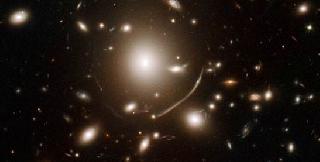
Galaxy cluster Abell 383. A Hubble photo
PARIS (BNS): Discovery of a distant galaxy, believed to be formed in the early years of the Universe but containing surprisingly old and faint stars instead of bright ones has led astronomers to suggest that the first galaxies have been around in the cosmos for a lot longer than previously thought.
The new galaxy, visible through a cluster of galaxies called Abell 383, was spotted by a team of astronomers led by Johan Richard.
The team discovered the galaxy in recent observations from the NASA/ESA Hubble space telescope, verified it with observations from the Spitzer telescope and measured its distance using W M Keck Observatory in Hawaii.
After spotting the galaxy, the team carried out spectroscopic observations with the Keck-II telescope. Spectroscopy is the technique of breaking up light into its component colours.
By analysing these spectra, the team was able to make detailed measurements of the galaxy's “redshift” and infer information about the properties of its component stars.
The galaxy’s redshift – a measure of time elapsed since the Big Bang as well as of the object’s distance – was put at 6.027, which means it has been there when the Universe was around 950 million years old.
However, some dramatically different features separated the galaxy from other distant galaxies that have been observed, and generally shine brightly with only young stars, said the researchers.
“When we looked at the spectra, two things were clear. The redshift placed it very early in cosmic history, as we expected. But the Spitzer infrared detection also indicated that the galaxy was made up of surprisingly old and relatively faint stars. This told us that the galaxy was made up of stars already nearly 750 million years old – pushing back the epoch of its formation to about 200 million years after the Big Bang, much further than we had expected,” explained Eiichi Egami, part of the research team.
Richard, the lead researcher, said: “We have discovered a distant galaxy that began forming stars just 200 million years after the Big Bang. This challenges theories of how soon galaxies formed and evolved in the first years of the Universe.”
Besides providing valuable clues about the history of galaxies and their formation, the discovery may also help in explaining how the Universe became transparent to ultraviolet light in the first billion years after the Big Bang.
In the early years of the cosmos, a diffuse fog of neutral hydrogen gas blocked ultraviolet light in the Universe. Some source of radiation must therefore have progressively ionised the diffuse gas, clearing the fog to make it transparent to ultraviolet rays as it is today — a process known as reionisation.
Astronomers believe that the radiation that powered this reionisation must have come from galaxies. But so far, nowhere near enough of them have been found to provide the necessary radiation. This discovery may help solve this enigma.
“It seems probable that there are in fact far more galaxies out there in the early Universe than we previously estimated — it’s just that many galaxies are older and fainter, like the one we have just discovered,” said co-author Jean-Paul Kneib.
“If this unseen army of faint, elderly galaxies is indeed out there, they could provide the missing radiation that made the Universe transparent to ultraviolet light,” the researcher said.
The researchers report their findings in the journal Nature.
 Previous Article
Previous Article Next Article
Next Article












The Indian Air Force, in its flight trials evaluation report submitted before the Defence Ministry l..
view articleAn insight into the Medium Multi-Role Combat Aircraft competition...
view articleSky enthusiasts can now spot the International Space Station (ISS) commanded by Indian-American astr..
view article